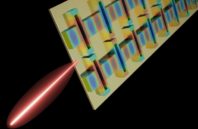A terahertz laser designed by MIT researchers is the first to reach three key performance goals at once — high constant power, tight beam pattern, and broad electric frequency tuning — and could thus be valuable for a wide range of applications in chemical sensing and imaging.
The optimized laser can be used to detect interstellar elements in an upcoming NASA mission that aims to learn more about our galaxy’s origins. Here on Earth, the high-power photonic wire laser could also be used for improved skin and breast cancer imaging, detecting drugs and explosives, and much more.
The laser’s novel design pairs multiple semiconductor-based, efficient wire lasers and forces them to “phase lock,” or sync oscillations. Combining the output of the pairs along the array produces a single, high-power beam with minimal beam divergence. Adjustments to the individual coupled lasers allow for broad frequency tuning to improve resolution and fidelity in the measurements. Achieving all three-performance metrics means less noise and higher resolution, for more reliable and cost-effective chemical detection and medical imaging, the researchers say.

 (585) 768-2513
(585) 768-2513

